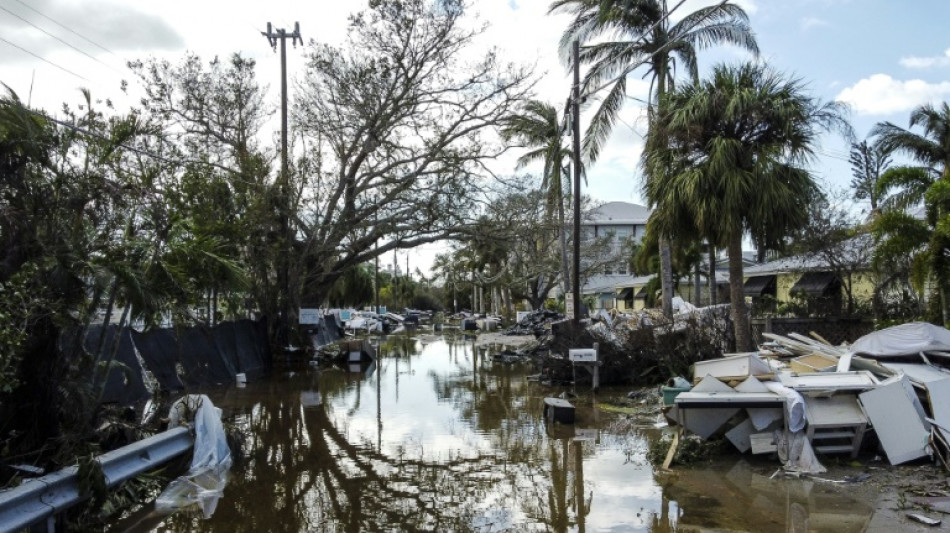
| RBGPF | 0% | 78.35 | $ | |
| JRI | 0.29% | 13.79 | $ | |
| BCC | -1.66% | 73.05 | $ | |
| CMSD | -0.3% | 23.25 | $ | |
| SCS | -0.56% | 16.14 | $ | |
| NGG | -0.66% | 75.41 | $ | |
| GSK | -0.33% | 48.41 | $ | |
| CMSC | -0.21% | 23.43 | $ | |
| RELX | -0.55% | 40.32 | $ | |
| AZN | 0.17% | 90.18 | $ | |
| RIO | -0.92% | 73.06 | $ | |
| BCE | 1.4% | 23.55 | $ | |
| BTI | -1.81% | 57.01 | $ | |
| VOD | -1.31% | 12.47 | $ | |
| BP | -3.91% | 35.83 | $ | |
| RYCEF | -0.34% | 14.62 | $ |
US braces for intense hurricane season as climate agency is gutted

The US National Oceanic and Atmospheric Administration (NOAA) on Thursday predicted a more intense Atlantic hurricane season this year -- even as the Trump administration moves to gut the agency's workforce and slash its budget.
NOAA is forecasting a 60 percent chance of an above-normal season, with between 13 to 19 named storms with winds of 39 mph (63 kph) or higher.
Of those, six to 10 are expected to become hurricanes with winds of 74 mph or higher, including three to five major hurricanes classed as categories three, four, or five, with sustained winds of at least 111 mph.
There is also a 30 percent chance of a near-normal season and a 10 percent chance of a below-normal season, the agency said.
The administration is also seeking to dismantle the Federal Emergency Management Agency (FEMA), calling for it to be shut down and its duties instead handed to individual states.
FEMA's acting head, Cameron Hamilton -- who was appointed by the Trump administration -- was fired earlier this month after saying that eliminating the agency was not "in the best interests of the American people."
- Warming oceans -
The forecast cites a confluence of factors: neutral conditions in the El Nino–Southern Oscillation (ENSO) climate pattern, warmer-than-average ocean temperatures, predictions of weak wind shear, and increased activity from the West African Monsoon -- the starting point for Atlantic hurricanes.
"As we witnessed last year with significant inland flooding from hurricanes Helene and Debby, the impacts of hurricanes can reach far beyond coastal communities," said Acting NOAA Administrator Laura Grimm in a statement.
"NOAA is critical for the delivery of early and accurate forecasts and warnings, and provides the scientific expertise needed to save lives and property."
But Rick Spinrad, the former NOAA administrator, told AFP he was deeply concerned about the agency's ability to respond following mass layoffs of meteorologists, technicians and other key personnel, spearheaded by Elon Musk's so-called "Department of Government Efficiency."
"I worry about the ability to fly the aircraft, run the models, answer the phones as these storms start bearing down on the country -- at the same time that the Weather Service is going to have to be dealing with tornadoes, wildfires, floods, extreme precipitation," said Spinrad.
Seawater temperatures have been rising for decades as a result of burning fossil fuels, Spinrad added. "So it's not a surprise, and undoubtedly, climate change has contributed to some of the ocean temperatures that are a major factor in this forecast."
President Donald Trump is seeking to cut NOAA's research operations budget by $1.3 billion next year. Project 2025 -- the conservative blueprint the administration is using to guide its second-term agenda -- has labeled the agency a key driver of "climate alarmism."
Last year, five storms that were big enough that they were assigned names caused economic losses exceeding a billion dollars, adjusted for inflation, according to NOAA.
The deadliest of these was Helene, responsible for 250 US deaths — the most since Hurricane Katrina in 2005.
The Trump administration announced earlier this month it will stop updating its billion-dollar disaster database, which for 44 years illustrated the rising cost of climate destabilization.
W.Sim--SG

 London
London

 Manchester
Manchester
 Glasgow
Glasgow
 Dublin
Dublin
 Belfast
Belfast
 Washington
Washington
 Denver
Denver
 Atlanta
Atlanta
 Dallas
Dallas
 Houston Texas
Houston Texas
 New Orleans
New Orleans
 El Paso
El Paso
 Phoenix
Phoenix
 Los Angeles
Los Angeles

